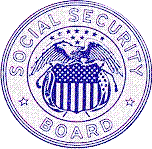Organizational History
Brief Graphic Organizational History
 |
The Social Security Administration (SSA) began life as the Social Security Board (SSB). The SSB was created at the moment President Roosevelt inked his signature on the Social Security Act (August 14, 1935 at 3:30 p.m.). The SSB was an entirely new entity, with no staff, no facilities and no budget. The initial personnel were donated from existing agencies, and a temporary budget was obtained from Harry Hopkins and the Federal Emergency Relief Administration. Frances Perkins , Secretary of Labor, offered one of her Assistant Secretaries, Arthur Altmeyer, to be an initial Board member, and she even gave her high-backed red-leather executive chair to Altmeyer since the SSB had no furniture. The Board itself consisted of three presidentially appointed executives and such staff as they needed to hire. |
 |
On 7/1/39 the Social Security Board lost its independent agency status when the new sub-cabinet level Federal Security Agency was created. The FSA encompassed the SSB, the Public Health Service, the Office of Education, the Civilian Conservation Corp., and the U.S. Employment Service. |
 |
On 7/16/46 the SSB was renamed the Social Security Administration under the President's Reorganization Plan of 1946. Arthur Altmeyer, who had been chairman of the Board of the SSB, became SSA's first Commissioner. |
 |
On 4/11/53 President Eisenhower abolished the FSA and created a new Department of Health, Education and Welfare (HEW). SSA was made part of this new cabinet agency. |
 |
HEW was replaced by the Department of Health & Human Services on 5/4/80. SSA was a major part of HHS until legislation signed by President Clinton on 8/15/94 returned SSA to it original status as an independent agency--effective 3/31/95. |
SSA: THE ROAD TO INDEPENDENCE
 SSA began life as an independent agency in 1935, became a sub-cabinet
agency in 1939, and returned full-circle to independent status in
1995. Throughout the years, arguments had been heard in the halls
of Congress that SSA should be returned to independent agency status.
This debate was given impetus in 1981 when the National Commission
on Social Security recommended that SSA once again become an independent
Social Security Board. The 1983 National Commission on Social Security
Reform (aka, the Greenspan Commission) again raised this issue and
recommended a special study be commissioned of the matter. This
special study was completed in 1984 and
it outlined several options for making SSA an independent agency.
This led to numerous legislative proposals in the ensuing years
and in 1994 the legislation passed both houses of Congress unanimously.
(See statements of support by Congressional
officials.)
SSA began life as an independent agency in 1935, became a sub-cabinet
agency in 1939, and returned full-circle to independent status in
1995. Throughout the years, arguments had been heard in the halls
of Congress that SSA should be returned to independent agency status.
This debate was given impetus in 1981 when the National Commission
on Social Security recommended that SSA once again become an independent
Social Security Board. The 1983 National Commission on Social Security
Reform (aka, the Greenspan Commission) again raised this issue and
recommended a special study be commissioned of the matter. This
special study was completed in 1984 and
it outlined several options for making SSA an independent agency.
This led to numerous legislative proposals in the ensuing years
and in 1994 the legislation passed both houses of Congress unanimously.
(See statements of support by Congressional
officials.)
President Clinton signed the bill on August 15, 1994 (59 years and
one day after FDR signed the original Act). (See
text of President Clinton's remarks at the signing) And on March
31, 1995 at a ceremony at SSA Headquarters
in Baltimore, SSA once again became an independent
agency.
SSA Brief Narrative Organizational History
In 1983, a Congressional Study Panel produced the following brief narrative history of the main organizational changes at SSA for the period 1935-1983.
CONGRESSIONAL PANEL ON SOCIAL SECURITY ORGANIZATION
ORGANIZATIONAL HISTORY OF SSA
COMMITTEE ON ECONOMIC SECURITY (1934) -
This Committee was established by President Roosevelt in June 1934 (Executive Order No. 6757) to develop a comprehensive social insurance system covering all major personal economic hazards with a special emphasis on unemployment and old age insurance. The Committee's legislative recommendations were presented to the President in January 1935, and introduced to Congess for consideration shortly thereafter. A compromise Social Security Bill was signed by the President on August 14, 1935.
SOCIAL SECURITY BOARD (1935) -
A three-member Board was established to administer the Social Security Act. It was responsible for old age insurance, unemployment compensation and public assistance titles of the Social Security Act. The Chairman of the Board reported directly to the President until July 1939 when the Board was placed organizationally under the newly established Federal Security Agency. The original Social Security Board consisted of the three member Board, an Executive Director, three Operating Bureaus, five Service Bureaus and Offices and 12 Regional offices.
BIRTH OF THE BUREAUS (1935) -
The Bureau of Federal Old-Age Benefits, renamed the Bureau of Old-Age Insurance (BOAI) in 1937, was created in December 1935 and was the forerunner of today's Social Security Administration. The Bureau was responsible for Title II of the Social Security Act and its functions included: the maintenance of wage records; supervision of field offices; examination and approval of claims, including related claims functions (for certification of payments recovery of excess payments, and hearing and deciding appealed cases); and the making of actuarial estimates.
FIRST FIELD OFFICES (1936) -
It was apparent from the beginning that the scope of the Title II program (old age benefits) would require considerable decentralization. The first step in this direction was the establishment of twelve regional offices attached to the Social Security Board with Regional Representatives for each program. The Bureau of Old Age Insurance concurrently began to establish field offices in October 1936 for public contact and 100 were in operation by February 1937.
PRESIDENT'S REORGANIZATION PLAN NO. 1 (1939) -
This established the Federal Security Agency (FSA), and the Social Security Board became a part of that agency. The FSA also administered the programs of the U.S. Public Health Service, Office of Education, National Youth Administration and Civilian Conservation Corps. The U.S. Employment Service and the Bureau of Unemployment Compensation were consolidated into the Bureau of Employment Security under the Social Security Board. The only administrative change was the transfer of the General Counsel and personnel functions to a central function under the FSA Administrator. The FSA Administrator permitted the Social Security Board to continue its program in an independent manner. The Bureau of Old Age Insurance was renamed "Bureau of Old-Age and Survivors Insurance" (BOASI) when the President signed the Amendments to Title II of the Social Security Act on August 10, 1939, which provided benefits for dependents and survivors of insured workers, and made other major changes. In 1940, a Control Division was added to handle the increased claims load resulting from the 1939 amendments. Finally, a Training Section was established in the Director's Office to take over the complete training program, a part of which had previously been handled by the Social Security Board.
ESTABLISHMENT OF AREA OFFICES (PAYMENT CENTERS) (1942) -
Because of the war-time scarcity of space in Washington and a marked increase in the benefit rolls, the central offices of the Bureau of Old Age and Survivors' Insurance were moved to Baltimore in 1942. At the same time Area Offices were opened in Philadelphia, New York, Chicago, San Francisco, and New Orleans for the certification and recertification of claims. The Control Division was replaced by the Claims Control Division and the old Claims Division by the Claims Policy Division. The adjudication of claims was shifted to the field offices, leaving the responsibility for claims review in the Claims Control Division and its area offices.
ESTABLISHMENT OF SOCIAL SECURITY ADMINISTRATION (1946) -
The President's reorganization Plan No. 2, effective in July 1946, abolished the Social Security Board and placed its functions under the newly established Social Security Administration (still under FSA). The FSA Administrator established the position of Commissioner to head the Social Security Administration (SSA). Several administrative functions (i.e., personnel, procurement, information services, etc.) from the Social Security Board were incorporated into SSA at this time.
CHANGES IN REGIONAL OFFICES (1948) -
In August 1948, following the transfer of the Regional Offices from the Social Security Administration to the Federal Security Administration, new SSA regions were established. Also, in 1948, a Division of Management Planning and Services was created within the Bureau of Old Age and Survivors Insurance to address problems created as a result of tremendous growth in the size of the Bureau.
DEPARTMENT OF HEALTH, EDUCATION AND WELFARE ESTABLISHED (1953)
The Federal Security Agency was abolished and its functions transferred to the new Department of Health, Education and Welfare (HEW). The Bureau of Federal Credit Unions was transferred to the Social Security Administration and the Commissioner's position was designated as a presidential appointee requiring Senate confirmation.
ESTABLISHMENT OF DIVISION OF DISABILITY OPERATIONS (1954) -
A modified (disability) freeze program, the precursor of the present disability program, was enacted as a part of the 1954 amendments. The Division of Disability Operations was founded to provide unified program, policy, procedural and operational leadership for this new program.
DIVISION OF SOCIAL SECURITY IN TWO PARTS (1963) -
On January 28, 1963, a reorganization in HEW retained the old-age, survivors and disability program functions in the Social Security Administration and established a new Welfare Administration to administer five Federal-State programs (the Children's Bureau, Bureau of Family Services, the Special Staff on Aging, and the Juvenile Delinquency and Youth Development Staff). The Bureau of Hearings and Appeals, the Office of the Actuary, and the Division of Program Research continued as units of SSA. The Bureau of Federal Credit Unions was still affiliated with SSA but only for administrative support. This split effectively made the old BOASI and other legislated social insurance programs into the modern day Social Security Administration.
PROGRAM BUREAUS ESTABLISHED (1965) -
The 1965 Amendments not only increased the scope and complexity of OASI and DI programs, but established the Health Insurance Program (Title XVIII) which became known as Medicare. A reorganization was effected which established four program Bureaus (Retirement and Survivors Insurance, Disability Insurance, Health Insurance, and Federal Credit Unions). A centralized record keeping operation, the Bureau of Data Processing and Accounts, was established to service all programs as well as a single field organization. Five functional staff units with agency-wide responsibility for program evaluation and planning, actuarial functions, public affairs, management and research functions were also established. Also at this time, the regional presence was enhanced by the establishment of the ten Regional Commissioners who served as the Commissioner's representatives and were responsible for evaluating and coordinating the agency operations. It is notable that the Regional Commissioners were not delegated "line authority," so they might retain their objectivity and detachment.
BUREAU OF SUPPLEMENTAL SECURITY INCOME (SSI) ESTABLISHED (1973)
The 1972 Amendments created the Supplementary Security Income (SSI) program and a new bureau was established in 1973. There remained only four program bureaus, however, for the Bureau of Federal Credit Unions left the agency in March 1970.
1975 REORGANIZATION OF SSA -
The Commissioner of Social Security announced a reorganization of the Agency in January 1975. The new organization significantly reduced the span of control of the Commissioner by consolidating eleven functions into only five functions and by placing the Regional Commissioners under an Associate Commissioner for Program Operations. The Regional Commissioners did receive line authority (through the Associate Commissioner for Program Operations) at this time for all cash benefit operations. Significant changes included: (1) the establishment of four Associate Commissioners for Operations, Program Policy and Planning, External Affairs and Management and Administration; (2) creation of a new policy and regulation making organization; (3) creation of a Commissioner-level organization dedicated to the long range improvement of SSA's automated systems; and (4) the creation of a centralized program evaluation and quality assurance program.
HEW REORGANIZATION (1977) -
This reorganization established the Health Care Financing Administration (HCFA) and abolished the Social and Rehabilitation Service (SRS). HCFA received Medicare (Bureau of Health Insurance) from SSA which had implemented and run the program since 1965. SSA received the responsibility for the Aid to Families with Dependent Children (AFDC) and the Commissioner of SSA became the ex-officio Director of the HEW Office of Child Support Enforcement (OCSE). Some policy functions also transferred to HCFA but other functions (i.e., computer support and field office services) continued to be performed by SSA. SSA also received cash assistance functions from SRS which encompassed Cuban and Indochinese refugee programs and the U.S. Repatriate Programs.
FUNCTIONAL REORGANIZATION OF SSA (1979) -
A newly appointed Commissioner of Social Security announced a reorganization along functional lines. The intended results were to: (1) improve the communications, policy development and decision making processes; (2) eliminate duplication; (3) elevate the field organization back into the main stream of headquarters activities, and (4) consolidate systems functions. Two deputies were created, one for operations and the other for program policy issues. An Executive Secretariat was created to enhance communications and ten Associate Commissioners along functional lines "to provide program direction and leadership." This reorganization was followed by a reorganization for the field structure under the Regional Commissioners. Unlike the 1975 Reorganization which was never fully implemented, it was completed in less than a year.
ORGANIZATIONAL REALIGNMENTS OF SSA (1980-1983) -
Fine tuning by succeeding Commissioners who found the span of control too broad under the 1979 reorganization was implemented over the next four years. Efforts to modify the organization to make it more responsive to changing mission requirements resulted in the following changes: (1) the consolidation of the public information and governmental affairs functions; (2) the abolishment of the Associate Commissioner for Operating Policy and Procedures; (3) the establishment of four Deputy Commissioners including one for systems and another for management and assessment; and (4) the creation of six new Associate Commissioners, including two for systems requirements and integration functions; three for the RSI, SSI and DI programs and one for the field.